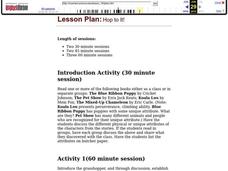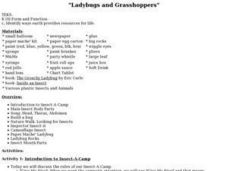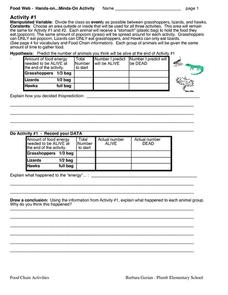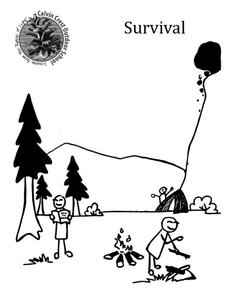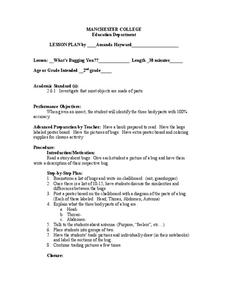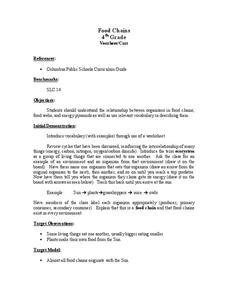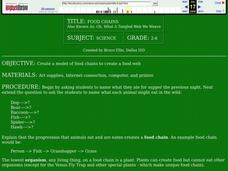Curated OER
Positive/Negative Bugs
Bugs can be creepy - and fun! Kids create a positive and negative design by repeatedly drawing a simple insect overlaid with a geometric shape. The outcome is really neat and will help build spacial reasoning, visual acuteness,...
Curated OER
Hop To It!
Learners explore grasshoppers. In this grasshoppers lesson, students measure the jumping distance of live grasshoppers. Learners then record the jumping distance of people in their group. Students record the distances and...
Curated OER
Insect Anatomy
Break down insect anatomy with this learning exercise! Class members diagram insect anatomy by drawing a line from the names of grasshopper body parts to the corresponding parts on an image of a grasshopper. The learning exercise...
School Specialty
The Tortoise and the Hare - Drawing Conclusions/Predictions Outcomes
Does the fastest one always win the race? Look deeper into The Tortoise and the Hare with a set of discussion questions for before, during, and after reading the story.
Curated OER
"Ladybugs and Grasshoppers"
Learners paricipate in number of activities related to ladybugs and grasshoppers.
Curated OER
Neurons and the Nervous System
The highlight of this series is activitiy #4. Anatomy pupils examine slides of three unknown cells. With the function of the nervous system in mind, they consider the structure of each and try to guess which one is part of that system....
Curated OER
Food Chain Activities
Transform young biologists into grasshoppers, lizards, and hawks as you teach them about food chains in an interactive life science simulation. Working collaboratively to act out three different scenarios involving...
Curated OER
Create An Insect
Young scholars create a new species of insect. They create a list of insect characteristics and use this as a springboard to draw an insect of their own. Students write a brief descriptive paragraphs about their insect, giving...
Curated OER
Big Blue Spider and Little Red Spider Retold
In this reading instructional activity, students listen to the fable called Big Blue Spider and Little Red Spider Retold by Ellen Baumwoll. Students draw illustrations or describe what they remembered form the story.
Curated OER
Pyramid of Biomass
Students interpret data to demonstrate biomass and number pyramids. They use information to draw conclusions and examine an example of biological magnification.
Curated OER
Letter G
In this letter g worksheet, 1st graders focus on words beginning with the letter sound. Students draw a line matching each of the 5 pictures to their corresponding words.
Curated OER
Food Chains
Learners take a look at the relationship between organisms in food chains, food webs, and energy pyramids. After an opening demonstration by the teacher, pupils are split up into groups. Each one is assigned an environment such as:...
Calvin Crest Outdoor School
Survival
Equip young campers with important survival knowledge with a set of engaging lessons. Teammates work together to complete three outdoor activities, which include building a shelter, starting a campfire, and finding directions in the...
Curated OER
All About Seeds!
How do fruits relate to flowers and seeds? Identify the seeds and their purpose with a coloring activity for kindergartners. Once they color the seeds of apples, bananas, and peas (among others), kids get hands-on experience with bean...
Curated OER
Name that animal
A great way to classify organisms, is by counting the number of legs it has or how it moves. Little ones count the legs on five different creatures, then match the leg count to the proper animal name. Tip: Have them come up with other...
Curated OER
Munching on Mixtures
Third graders view the food Power Tower and discuss the food groups. In this food lesson plan, 3rd graders cut out favorite foods from magazines. Students read Cloudy with a Chance of Meatballs and record the foods they would...
Silos & Smokestacks National Heritage Area
Life as a Pioneer
Students examine historical documents and research why early pioneers settled on the Iowa prairie. They review maps, describe the impact of railroading, describe life in pioneer times, and identify the effects of drought, prairie fire,...
Curated OER
What's Bugging You?
Second graders investigate insects. In this parts of a whole, 2nd graders discuss what the three body parts of an insect are as well as the antenna. Students create their own insect labeling each body part and antenna.
Curated OER
Food Chains
Fourth graders study food chains, producers, consumers, and decomposers. They play a food chain game and create food chain mobiles or posters. They take a nature hike around the school and observe various parts of a food chain.
Curated OER
Species Charades
Students identify endangered species. In this endangered species lesson, the teacher leads a discussion about endangered species, then the class plays a game of charades to pantomime animal behavior.
Curated OER
Food Chains
Fourth graders investigate food chains. They review cycles and discuss ecosystems. They select an environment and create a food chain in small groups. They write their food chain and label it for the class to evaluate. They create...
Curated OER
The Importance of Observation
First graders practice observing items in small areas. In this scientific observation lesson, 1st graders complete a worksheet that shows a child looking at a small patch of grass. They make a list of items that the child sees. They...
Curated OER
Diversity And Adaptations Of Organisms
Seventh graders demonstrate the processes of science by posing questions and investigating phenomena through language, methods and instruments of science. They study the body features or systems of several animals.

